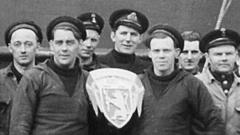This article explores the daring covert missions that connected Scotland and Norway amidst the horrors of Nazi occupation, providing a lifeline for resistance fighters and refugees alike.
**The Legacy of the Shetland Bus: Norway's Secret Resistance Against Nazi Occupation**

**The Legacy of the Shetland Bus: Norway's Secret Resistance Against Nazi Occupation**
The untold story of the Shetland Bus operation helps illuminate the bravery and resilience of Norwegians during World War II.
The Shetland Bus operation, often resembling a plot from a thrilling spy novel, was a covert mission established to aid the Norwegian resistance against Nazi Germany during World War II. Under the cloak of darkness and in the harrowing winter months, small fishing boats set sail from Scotland's Shetland Islands to deliver essential supplies and agents to various locations along Norway's coastline.
As part of commemorating the 80th Anniversary of Victory in Europe (VE) Day, six of the original vessels from the Shetland Bus fleet are retracing the poignant journey from Bergen, Norway, back to Shetland, aimed to coincide with the VE Day celebrations on Tuesday.
The saga commenced with Norway's invasion by Nazi forces on April 8, 1940. The Norwegian government, along with Royal Family members like King Haakon VII, found refuge in London. Many Norwegians risked their lives aboard fishing boats to escape to the UK.
In July 1940, British Prime Minister Winston Churchill established the Special Operations Executive (SOE) to conduct espionage and sabotage across occupied Europe, and the Shetland Bus convoys emerged as a critical part of this effort, supporting the resistance in Norway. From 1940 to 1945, the fleet undertook 200 treacherous North Sea crossings, transporting many resistance agents, tons of arms and supplies, and rescuing over 300 Norwegian refugees.
Notably, these journeys typically occurred during the winter, capitalizing on the long hours of darkness while minimizing the likelihood of detection by German patrols, making for perilous crossings. Crews braved the tumultuous North Sea while evading German aircraft and boats.
One remarkable story involves the M/K Arnefjord, which set out on September 27, 1941, from Hernar carrying 20 refugees. Despite starting calm, a vicious storm hit, causing considerable seasickness and prompting discussions about turning back. Ultimately, the Arnefjord successfully delivered its passengers to Mousa in Shetland, while not all boats that crossed that stormy weekend were so fortunate. Tragically, ten fishing vessels were lost, and 44 men perished.
Current captain of the M/K Arnefjord, Morten Neset, reflects on the critical role that these crossings played in demonstrating solidarity to the Norwegian populace. "It was vital for them to know someone was 'standing up for them' against the occupation," he stated.
Bill Moore, representing the Shetland Bus Friendship Society, emphasized the significance of the operation in boosting morale among Norwegians, claiming that escaping through the “Shetland Bus” had become a coded message for many.
As the Liberation Convoy departs Norway at 7:00 PM on Sunday, it is expected to arrive in Lerwick the following morning for VE Day tributes, reinforcing the enduring bonds and collective memory of resistance across the North Sea.
As part of commemorating the 80th Anniversary of Victory in Europe (VE) Day, six of the original vessels from the Shetland Bus fleet are retracing the poignant journey from Bergen, Norway, back to Shetland, aimed to coincide with the VE Day celebrations on Tuesday.
The saga commenced with Norway's invasion by Nazi forces on April 8, 1940. The Norwegian government, along with Royal Family members like King Haakon VII, found refuge in London. Many Norwegians risked their lives aboard fishing boats to escape to the UK.
In July 1940, British Prime Minister Winston Churchill established the Special Operations Executive (SOE) to conduct espionage and sabotage across occupied Europe, and the Shetland Bus convoys emerged as a critical part of this effort, supporting the resistance in Norway. From 1940 to 1945, the fleet undertook 200 treacherous North Sea crossings, transporting many resistance agents, tons of arms and supplies, and rescuing over 300 Norwegian refugees.
Notably, these journeys typically occurred during the winter, capitalizing on the long hours of darkness while minimizing the likelihood of detection by German patrols, making for perilous crossings. Crews braved the tumultuous North Sea while evading German aircraft and boats.
One remarkable story involves the M/K Arnefjord, which set out on September 27, 1941, from Hernar carrying 20 refugees. Despite starting calm, a vicious storm hit, causing considerable seasickness and prompting discussions about turning back. Ultimately, the Arnefjord successfully delivered its passengers to Mousa in Shetland, while not all boats that crossed that stormy weekend were so fortunate. Tragically, ten fishing vessels were lost, and 44 men perished.
Current captain of the M/K Arnefjord, Morten Neset, reflects on the critical role that these crossings played in demonstrating solidarity to the Norwegian populace. "It was vital for them to know someone was 'standing up for them' against the occupation," he stated.
Bill Moore, representing the Shetland Bus Friendship Society, emphasized the significance of the operation in boosting morale among Norwegians, claiming that escaping through the “Shetland Bus” had become a coded message for many.
As the Liberation Convoy departs Norway at 7:00 PM on Sunday, it is expected to arrive in Lerwick the following morning for VE Day tributes, reinforcing the enduring bonds and collective memory of resistance across the North Sea.






















